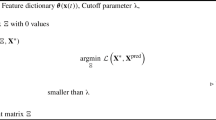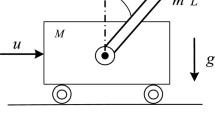Abstract
This paper presents a passivity condition of a haptic interface with the multirate wave transform (MWT). Although rate transitions at the wave communication line are achieved passively, the sample-and-hold for the continuous system still generates energy. Since the update rates of the sample-and-hold are high (or assumed to be high) in most cases, its effects are often ignored. However, as the update rate of the sample-and-hold decreases, more energy is generated and the whole haptic interface consequently becomes active. A passivity condition is derived for a system consisting of the sample-and-hold, MWT, and virtual environment (VE). An example study has shown that the minimum update rate of the sample-and-hold can be obtained by investigating the passivity condition. Experiments also have shown that stable force displays can be achieved with the proposed update rates.
Similar content being viewed by others
References
R. B. Gillespie and M. R. Cutkosky, “Stable userspecific rendering of the virtual wall,” Proc. of the ASME Int. Mech. Eng. Conf. and Exp., pp. 397–406, 1996.
R. J. Adams and B. Hannaford, “Stable haptic interaction with virtual environments,” IEEE Trans. Robot. Automat., vol. 15, no. 3, pp. 465–474, June 1999.
B. E. Miller, J. E. Colgate, and R. A. Freeman, “Environment delay in haptic systems,” Proc. of the IEEE Int. Conf. on Robot. Automat., pp. 2434–2439, 2000.
B. Hannaford and J. H. Ryu, “Time-domain passivity control of haptic interfaces,” IEEE Trans. Robot. Automat., vol. 18, no. 1, pp. 1–10, Feb. 2002.
S. Stramigioli, C. Secchi, A. J. van der Schaft, and C. Fantuzzi, “Sampled data systems passivity and discrete port-hamiltonian systems,” IEEE Trans. on Robotics, vol. 21, no. 4, pp. 574–587, Aug. 2005.
R. Anderson and M. Spong, “Bilateral control of teleoperation with time delay,” IEEE Trans. on Automat. Cont., vol. 34, no. 5, pp. 494–501, May 1989.
G. Niemeyer and J. E. Slotine, “Stable adaptive teleoperation,” IEEE J. of Oceanic Eng., vol. 16, no. 1, pp. 152–162, January 1991.
N. A. Tanner and G. Niemeyer, “High-frequency acceleration feedback in wave variable telerobotics,” IEEE/ASME Trans. on Mechatronics, vol. 11, no. 2, pp. 119–127, April 2006.
C. Secchi, S. Stramigioli, and C. Fantuzzi, “Digital passive geometric telemanipulation,” Proc. IEEE Int. Conf. Robot. Automat., pp. 3290–3295, 2003.
C. H. Cho, J. B. Song, and M. S. Kim, “Stable haptic display of slowly updated virtual environment with multirate wave transform,” IEEE/ASME Trans. on Mechatronics, vol. 13, no. 5, pp. 566–575, Oct. 2008.
J. E. Colgate and G. G. Schenkel, “Passivity of a class of sampled-data systems: application to haptic interfaces,” J. of Robotic Systems, vol. 14, no. 1, pp. 37–47, Jan. 1997.
F. Barbagli, D. Prattichizzo, and K. Salisbury, “Multirate analysis of haptic interaction stability with deformable objects,” Proc. of IEEE Conf. on Decision and Control, pp. 917–922, 2002.
O. R. Astley and V. Hayward, “Multirate haptic simulation achieved by coupling finite element meshes through norton equivalents,” Proc. of the IEEE Int. Conf. on Robot. Automat., pp. 989–994, 1998.
S. H. Lee, C. C. Chung, and S. M. Suh, “Multirate digital control for high track density magnetic disk drives,” IEEE Trans. on Magnetics, vol. 39, no. 2, pp. 832–837, March 2003.
D. W. Kim, J. B. Park, Y. H. Joo, and S. H. Kim, “Multirate digital control for fuzzy systems: LMIbased design and stability analysis,” Int. J. of Contr., Auto., and Sys., vol. 4, no. 4, pp. 506–515, 2006.
K. J. Åström and B. Wittenmark, Computer-Controlled Systems-Theory and Design, Prentice Hall, 1997.
S. S. Haykin, Active Netwok Theory, Addison-Wesley, 1970.
Author information
Authors and Affiliations
Corresponding author
Additional information
Recommended by Editorial Board member Hyoukryeol Choi under the direction of Editor Jae-Bok Song. This research was supported by the MKE (The Ministry of Knowledge Economy), Korea, under the ITRC (Information Technology Research Center) support program supervised by the NIPA (National IT Industry Promotion Agency) (NIPA-2010-C1090-1021-0013).
Changhyun Cho received his B.S. and M.S. degrees in Mechanical Engineering from Kyunghee University, Korea, in 1997 and 1999, respectively, and his Ph.D. degree in Mechanical Engineering from Korea University, Korea, in 2005. He was with the Center for Intelligent Robotics, Frontier 21 Program, at KIST from 2005 to Aug. 2008. He joined the faculty of the Dept. of Control, Instruments, and Robot, Chosun University, Kwangju, Korea in 2008, where he has been an Assistant Professor since 2008. His current research interests are in the fields of mechanism design and the control of robotic systems.
Rights and permissions
About this article
Cite this article
Cho, C. Effect of sample-and-hold on a haptic interface with the multirate wave transform. Int. J. Control Autom. Syst. 8, 1250–1256 (2010). https://doi.org/10.1007/s12555-010-0610-0
Received:
Revised:
Accepted:
Published:
Issue Date:
DOI: https://doi.org/10.1007/s12555-010-0610-0




